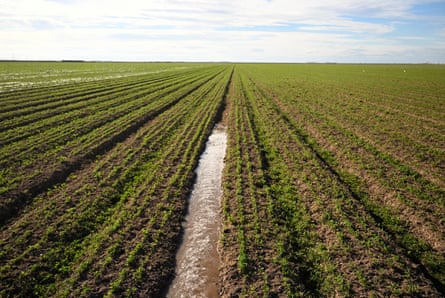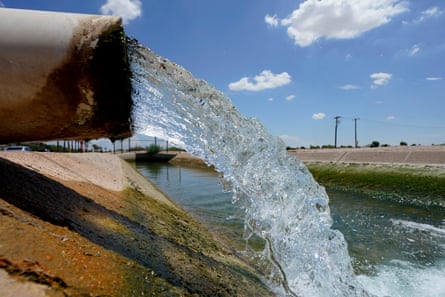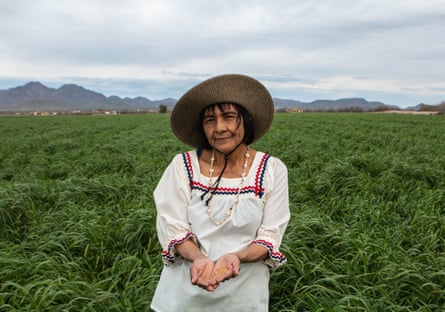Nancy Caywood worries about water constantly. Water – or the uncertainty of it – has kept the 69-year-old Arizona farmer awake at night since supplies began dwindling about two decades ago due to chronic overuse and drought in the American west.
During one particularly low point in late 2021, every field on the 255-acre family farm was either fallow, shrivelled or dormant. “The canal was dry, the reservoir was empty, it was raining at the wrong times … the farm was 100% unproductive and we were using savings to pay bills,” said Caywood, a third-generation farmer in Pinal county who grows mostly alfalfa and cotton – two of the most marketable and water-guzzling commodity crops.
“My dad started using the S-word, it was devastating, but we didn’t want to sell to solar,” added Caywood whose farmland is now surrounded by fallow fields, tumbleweed and solar farms.

And then last year’s Colorado River water rations kicked in, as water managers implemented drought contingency plans to safeguard Lake Mead and Lake Powell, the country’s two largest reservoirs left dangerously depleted by the climate crisis, unchecked urban sprawl and industrialized agriculture.
In 2022, the Colorado River water allocated for farmers in central Arizona – the state’s tri-county urban and agricultural heartland – was cut by 65% overall, but most Pinal county farmers lost 80% or more. This year the allocation is virtually zero, as the river’s complex priority system means farmers in central Arizona currently bear the brunt of the state’s reduced allocation.
This was the case even before this month’s historic deal in which Arizona, California and Nevada agreed a plan which would cut their Colorado water consumption by 13% over the next three years – if adopted. The move would avert the immediate prospect of more stringent cuts imposed by the federal government, but is unlikely to be enough to address long-term threats posed by the climate breakdown, unchecked development and subsidies-driven agriculture.
About half the irrigated farmland will be left unplanted in Pinal county this year, and hundreds of rural jobs have already been lost. Farms are having to rely almost exclusively on groundwater, further depleting the aquifers.
The region’s water crisis isn’t new and cuts were not entirely unexpected, yet most farmers have continued to farm the same water-guzzling crops using the same wasteful irrigation techniques – in part driven by perverse government incentives such as subsidies and crop insurance that do little to discourage the status quo, according to Gary Nabhan, an agricultural ecologist and expert on sustainable desert farming.
In some cases it seems to be getting worse: the production of alfalfa, a tall, thirsty and sun-loving perennial with deep roots that dries into a high-protein hay mostly used to feed cattle and horses, has risen by 7% in Arizona since water rationing began.
“For years policymakers and farmers punted the ball rather than seriously dealing with the water crisis, and so we now see farmers again forced to rely on groundwater – which is deep and expensive to pump,” said Nabhan, former chair of the Southwest Borderlands Food and Water Security program at the University of Arizona. “The fact that the alfalfa acreage has grown signals government policies continue to act against farmers making climate- and water-smart choices.”
Now Arizona is among seven states in the south-west fighting for the right to the river water. “Water is the biggest challenge for our farmers but commodity crops remain the most profitable with the biggest markets,” said Julie Murphee from the Arizona Farm Bureau.
Caywood is a case in point. To make ends meet she has branched into tourism, offering farm tours popular with children and retired snowbirds while her son leases land in a district that still receives some Colorado River water.
Yet both mostly farm alfalfa, which in Arizona is harvested eight or nine times a year – the highest crop yield in the country thanks to the long, sunny growing season. Such intensive farming requires a huge amount of water, and while Caywood has invested in technologies to reduce runoff when the fields are flooded, she is reluctant to spend money on less wasteful drip irrigation until the old leaky canal system is fully replaced – which could take years.
Notwithstanding growing criticism about alfalfa sucking the Colorado River basin dry, the leafy legume still makes economic sense for Caywood, a climate change sceptic, as demand is booming due to the insatiable demand from the beef, dairy and equine industries. And despite losing her Colorado River water this year, the short-term outlook for Caywood is looking up after heavy winter rains.
The farm is located in Pinal county’s San Carlos irrigation district – the only one which can draw water from the Gila River, a Colorado tributary, if and when it rains enough. In mid-March, the river’s Coolidge dam reservoir was half full, and Caywood had two alfalfa harvests under her belt – compared with just two during the entire year in 2021, and four in 2022.

“I’m not saying the drought is over, but to see the dam so full is thrilling. Agriculture is food security and freedom,” said Caywood. “I still wake up at night worrying about water, but the problem isn’t man-made, it’s cyclical.”
Caywood is upbeat after the rainy weather yet the even best-case global heating scenarios signal a hotter, drier climate for the south-west with diminished Colorado river flows in the long term.
And it’s not just about the water. Livestock – through cattle burps, manure management and the cultivation of feed crops – is heavily subsidized and responsible for nearly a third of the global human-made methane – a short-lived but powerful heat-trapping gas that accounts for nearly 25% of planet warming today.
“Refusing to change is just postponing the inevitable unhappy ending,” said Nabhan.
The history: a mess of our own making
The 1,450-mile Colorado River originates in the Rocky mountains and traverses seven US states, providing water for cities, farmland and hydroelectric dams, before reaching Mexico where it should flow 100 miles south into the Sea of Cortez.
It is one of the world’s most developed and regulated waterways, and today almost the entire flow is diverted for agricultural irrigation and urban water supply through an extensive system of dams, canals, reservoirs and aqueducts.
Who gets how much and for what, is determined by a complex stack of international treaties and national agreements dating back decades.
In 1922, the US Bureau of Reclamation, the government’s water agency within the interior ministry, divided the river among two groups of states: the upper basin – Utah, Wyoming, Colorado and New Mexico – and the lower basin – California, Nevada and Arizona. (Tribal nations were left out and spent decades fighting for water rights – even though Indigenous peoples have inhabited and farmed the Colorado basin for at least 8,000 years. The river runs dry in Mexico and has not flowed into the sea since 1998.)

The allocated shares were based on some half-baked science that hugely overestimated the river’s average flow even then – and failed to take into account the possibility of future droughts or climate change.
The natural annual replenishment of the river from snowmelt and rain has in recent decades been 20% lower than the past century’s average, with consumption outstripping refill frequently over the past 25 years.
At the end of 1999, Lake Mead and Lake Powell were both nearly full. At the end of 2022, after the worst mega-drought in 1,200 years, the reservoirs were three-quarters empty and dangerously close to “dead pool” status – at which point the water is too low to flow downstream or spin turbines to generate hydropower.
Dead pool would be catastrophic given that the river currently provides drinking water to 40 million people – including some of America’s most populous cities and 30 tribal nations – and irrigates almost 6m acres of ranch and farmland.
US and Mexican states agreed a drought contingency plan in 2019, but as the crisis deepened, the first-ever mandated cuts to allocations came into force in 2022. For Arizona, the river water allocation decreased by 18% in 2022, (512,000 acre-feet), but as Lake Mead continued to shrink it fell 21% (592,000 acre-feet) this year – the equivalent of 9% of the state’s total water use.
The cuts have been absorbed by central and southern Arizona which is served by the Central Arizona Project (Cap) – a 336-mile diversion canal that delivers water from the Colorado River to Maricopa, Pima and Pinal counties – a region that includes the country’s fifth biggest and hottest city, Phoenix. (Communities close to the river have more senior rights, and have so far been spared rationing.)
CAP, a river water wholesaler of sorts approved by Congress in the 1960s in large part to curb the overexploitation of groundwater, has concentrated previous cuts on agriculture. (This year’s allocation for irrigation is down 96%, while municipalities and industry have lost 3% and tribes 7%.)

The hierarchy of cuts dates back to a 2004 deal when the agriculture sector negotiated a lower water rate and debt relief in exchange for lower priority than tribes, towns and cities, and industry. As a result farmers have been the first to face restrictions in times of drought or maintenance – and they have known that the supply and price of Cap water was only guaranteed until 2030.
So while the drought rationing has been deeper and quicker than most expected, the need to adapt to less water has been known for years.
“Farmers always knew that the Colorado River water supply was finite, and the reality is we’re looking at a future with less water overall so they have to figure out how to farm with less … because groundwater is also a concern,” said DeEtte Person, Cap’s communications strategist.
In August the secretary of the interior, Deb Haaland, also known as the water master, will announce the Colorado River water allocation for 2024 – depending on the state of Lake Mead. And despite the short-term respite resulting from a good snowpack and rainy season, the water situation looks set to get worse for Arizona farmers.
Last week, Arizona, California and Nevada agreed a plan to cut the equivalent of a trillion gallons over the next three years. California, which is the largest beneficiary of river water, will absorb half the cuts, while farmers in Arizona, which uses most water per acre of land, will probably lose most.
The proposal, which broke a years-long stalemate and includes a federal compensation package, was described by experts as both historic and a Band-Aid.
Looking to the past for future solutions
Pinal county is Arizona’s third most populous county and one of America’s top producers of cattle, alfalfa, cotton, barley and durum wheat – crops which are mostly farmed on sprawling industrial agricultural operations. According to government figures from 2015, agriculture here accounted for more than 90% of the county’s water use compared with 70 to 75% statewide.
Pinal county has six irrigation districts that distribute water to farmland via a network of canals and ditches. Some were better prepared for the Colorado River cuts than others, having taken steps to acquire or restore wells for pumping more groundwater; made deals with urban treatment plants to use effluent water; and/or invested in leak-proofing the canal system to reduce wastage. Others have banked more heavily on urban sprawl reducing agricultural demand, or increased borrowing excess water from tribes and cities. (Some farms are not connected to an irrigation system, and rely solely on wells and rainfall.)

County-wide farmers are relying more heavily on groundwater – either directly by pumping wells on their own land or indirectly as the irrigation districts do the same.
“Cap helped restore the water table so this will remain a viable farming area on groundwater for some time – albeit on a much smaller scale,” said Paul Orme, whose law firm represents Pinal county’s six irrigation districts. “Even if all this pain helps the Colorado River system recover, going forward there will be good and bad rain years, with little farmers can count on.”
To survive, farmers will need to farm differently. And some understood that years ago.
Ramona Button and her family grow a diverse mix of commodity crops and drought-tolerant, native crops on about 4,000 acres scattered across the Gila River Indian reservation just south of Phoenix.
Ramona Farms includes the 10-acre plot that Button, who is of the Akimel O’odham or River People (also referred to as Pimas) farmed organically as a child with her father, but most of the lush green fertile fields had been fallow for decades after the community was displaced and denied water rights.
At least 10% of the farmland is organic and dedicated to growing heirloom tepary beans, heritage corn varieties, garbanzos and ancient grain wheats like Pima Club and White Sonora, which are part of Button’s mission to tackle diabetes and other diet-related health inequalities in Indian country.
“I wanted to bring back the healthy traditional foods our elders were raised on, and which use so much less water than commodity crops,” said Button, a former nurse who sells to restaurants, home cooks and stores nationwide.

Studying the desert-adapted native crops over the past five decades has helped Ramona’s husband and farm manager to adapt traditional farming knowledge and techniques for alfalfa, cotton, barley and durum wheat – the commodity crops which keep the farm economically viable. But Terry Button has also embraced cutting-edge water conservation technologies like laser- and GPS-guided land levelling, and uses far less water and synthetic fertiliser to grow alfalfa than most commercial operations.
They currently grow 14 crops, and this diversity means the farm is not as economically dependent on alfalfa, so Button extracts only four or five harvests a year, which is good for soil health and conserves water.
“Water scarcity has always been an issue, so the recent cuts have been real difficult, but didn’t come as a shock,” said Terry Button. “Crop diversity has so much value, it builds resilience and makes us more sustainable. We are losing farmers, but we want to show people that it can be done.”
